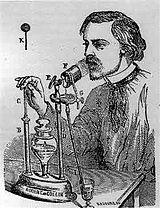Here’s a fun fact that I just read:
“The first “powered” or pressurized inhaler was invented in France by Sales-Girons in 1858.This device used pressure to atomize the liquid medication. The pump handle is operated like a bicycle pump. When the pump is pulled up, it draws liquid from the reservoir, and upon the force of the user’s hand, the liquid is pressurized through an atomizer, to be sprayed out for inhalation near the user’s mouth”

Sales-Girons pressurized
nebulizer from 1858.
So I guess vaping has been around since the mid 1800’s.
Here’s the rest of the history:
In 1864, the first steam-driven nebulizer was invented in Germany. This inhaler, known as “Siegle’s steam spray inhaler”, used the Venturi principle to atomize liquid medication, and this was the very beginning of nebulizer therapy. The importance of droplet size was not yet understood, so the efficacy of this first device was unfortunately mediocre for many of the medical compounds. The Siegle steam spray inhaler consisted of a spirit burner, which boiled water in the reservoir into steam that could then flow across the top and into a tube suspended in the pharmaceutical solution. The passage of steam drew the medicine into the vapor, and the patient inhaled this vapor through a mouthpiece made of glass.
The first electrical nebulizer was invented in the 1930s and called a Pneumostat. With this device, a medical liquid (typically adrenalin chloride, used as a bronchial muscle relaxant to reverse contriction) was made aerosol by the power from an electrical compressor. As an alternative to the expensive electrical nebulizer, many people in the 1930s continued to use the much more simple and cheap hand-driven nebulizer, known as the Parke-Davis Glaseptic.
In 1956, a technology competing against the nebulizer was launched by Riker Laboratories (3M), in the form of pressurized metered-dose inhalers, with Medihaler-iso (isoprenaline) and Medihaler-epi (adrenaline) as the two first products. In these devices, the drug is cold-fill and delivered in exact doses through some special metering valves, driven by a gas propellant technology (i.e. Freon or a less environmentally damaging HFA).
In 1964, a new type of electronic nebulizer was introduced: the “ultrasonic wave nebulizer”. Today the nebulizing technology is not only used for medical purposes. Ultrasonic wave nebulizers are also used in humidifiers, to spray out water aerosols to moisten dry air in buildings.
Some of the first models of electronic cigarettes featured an ultrasonic wave nebulizer (having a piezoelectric element vibrating and creating high-frequency ultrasound waves, to cause vibration and atomization of liquid nicotine) in combination with a vapouriser (built as a spray nozzle with an electric heating element). The most common type of electronic cigarettes currently sold, however, omit the ultrasonic wave nebulizer, as it was not found to be efficient enough for this kind of device. Instead, the electronic cigarettes now use an electric vaporizer, either in direct contact with the absorbent material in the “impregnated atomizer,” or in combination with the nebulization technology related to a “spraying jet atomizer” (in the form of liquid droplets being out-sprayed by a high-speed air stream, that passes through some small venturi injection channels, drilled in a material absorbed with nicotine liquid)."
 welcome aboard good to have ya around!
welcome aboard good to have ya around! any new stuff I read I will post here so everyone can stay informed.
any new stuff I read I will post here so everyone can stay informed.
